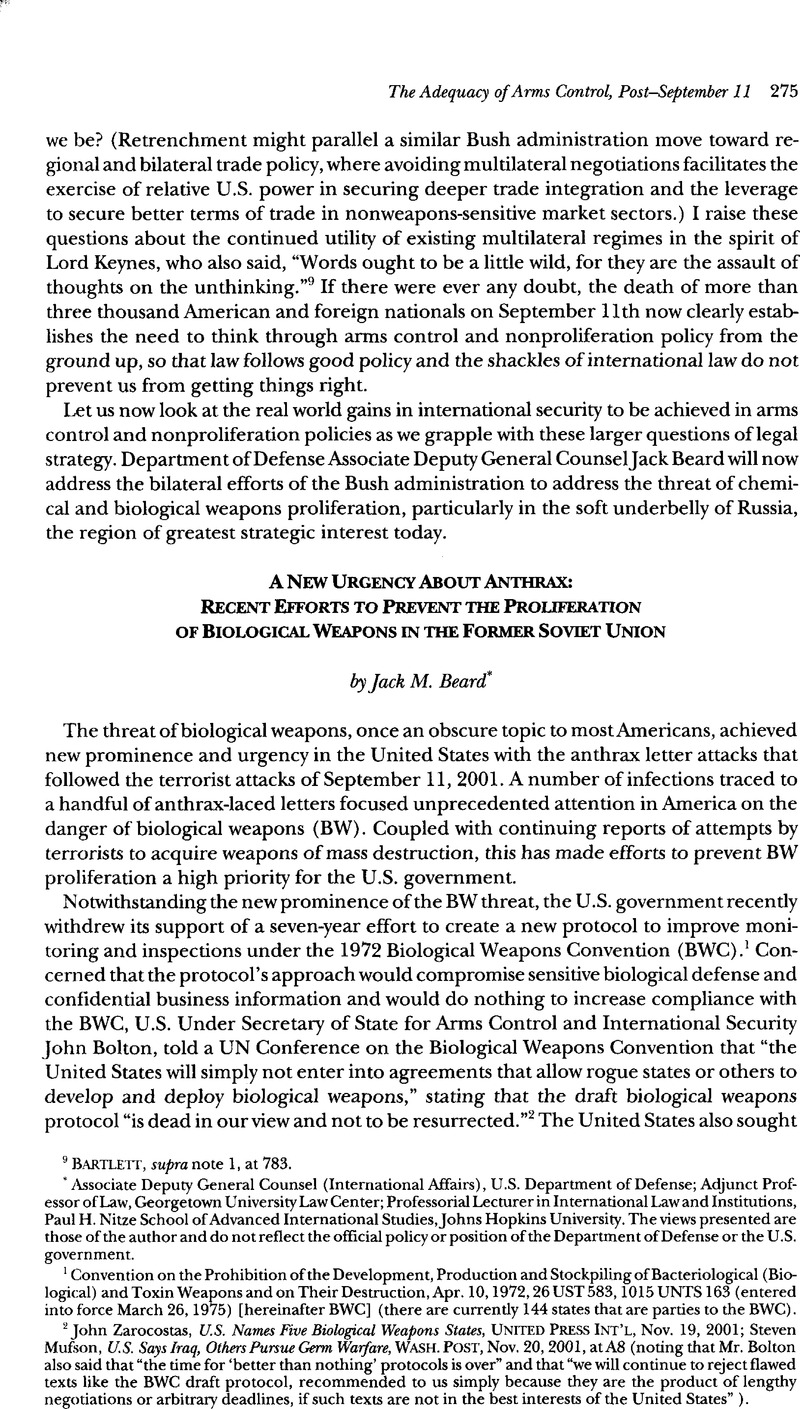No CrossRef data available.
Article contents
A New Urgency About Anthrax: Recent Efforts to Prevent the Proliferation of Biological Weapons in the Former Soviet Union
Published online by Cambridge University Press: 28 February 2017
Abstract

- Type
- The Adequacy of International Law for Arms Control, Post-September 11
- Information
- Copyright
- Copyright © American Society of International Law 2002
References
1 Convention on the Prohibition of the Development, Production and Stockpiling of Bacteriological (Biological) and Toxin Weapons and on Their Destruction, Apr. 10, 1972,26 UST 583,1015 UNTS163 (entered into force March 26,1975) [hereinafter BWC] (there are currently 144 states that are parties to the BWC).
2 John Zarocostas, U.S. Names Five Biological Weapons States, United Press Int’l, Nov. 19, 2001; Steven Mufson, U.S. Says Iraq, Others Pursue Germ Warfare, Wash. Post, Nov. 20, 2001, at A8 (noting that Mr. Bolton also said that “the time for ‘better than nothing’ protocols is over” and that “we will continue to reject flawed texts like the BWC draft protocol, recommended to us simply because they are the product of lengthy negotiations or arbitrary deadlines, if such texts are not in the best interests of the United States”).
3 Bush Administration Irresponsible in Face of Bioweapons Threat: U.S. Kills Biological Weapons Con/., Puts U.S. at Risk, U.S. Newswire, Dec. 7, 2001 (noting that the U.S. position “so shocked delegates” that European Union representatives referred to the U.S. delegation as “liars”); Herve Kempf, Is US Power a Force for Good in the World? Manchester Guardian Wkly., Jan. 23, 2002, at 29 (arguing that U.S. actions such as the opposition to the biological weapons protocol show that “the Americans have adopted a deliberately unilateral stance”).
4 President’s News Conference with Presiden t Vladimir Putin of Russia, Public Papers of the Presidents, vol. 37, No. 46, Nov. 19, 2001, at 1.
5 Jonathan B. Tucker, Bioweapons from Russia: Stemming the Mow, Issues in Sci. & Tech. Online, Spring 1999, at 1-2, available at <http://www.nap.edu/issues>.
6 Id. at 1.
7 Gulbarshyn Bozheyeva et al., Former Soviet Biological Weapons Facilities in Kazakhstan: Past, Present, Future, in 8 Occasional Paperno. 1, at 8 (Monterey Inst., Center for Nonproliferation Stud.June 1999). The BW facilities at Stepnogorsk occupied two square kilometers and consisted of 25 buildings; they were capable of producing up to 300 metric tons of weapons-grade anthrax over a 10-month period.
8 Id. at 11.
9 Although both Kazakhstan and Uzbekistan own parts of Vozrozhdeniye Island, the BW-related infrastructure and testing range is located on the Uzbekistan portion of the island.
10 Miller, Judith, Poison Island: a Special Report; at Bleak Asian Site, Killer Germs Survive, N.Y. Times, June 2, 1999, at A1 Google Scholar. In the spring of 1988, Soviet scientists secretly transferred hundreds of tons of militarized anthrax bacteria in giant steel canisters to Vozrozhdeniye Island, where they were dumped into huge pits and only partially destroyed.
11 Testimony of Vann Van Diepen, Deputy Assistant Secretary of State for Nonproliferation, Hearing Before the International Security, Proliferation and Federal Services Subcommittee of the Senate Governmental Affairs Committee on the Nonproliferation Assistance Coordination Act, Federal news service, Nov. 29,2001. The ISTC, which began its work in 1994, is funded by private companies, the European Union, and the governments of Japan, Norway, Russia, South Korea, and the United States. A similar institution, the Science and Technology Center in Ukraine, began its work in 1995.
12 Id.
13 Judith Miller, The Germ Warriors: A Special Report; Iranians, Bioweapons in Mind, Lure Needy Ex-Soviet Scientists, N.Y. Times, Dec. 8, 1998, at Al.
14 Prepared testimony of Marshall Billingslea, Deputy Assistant Secretary of Defense, Hearing Before the Senate Committee on Governmental Affairs Subcommittee on International Security, Proliferation and Federal Services on the Nonproliferation Assistance Coordination Act, Federal news service, Nov. 29, 2001.
15 Agreement Between the Department of Defense of the United States of America and the Ministry of Energy, Industry, and Trade of the Republic of Kazakhstan Concerning the Elimination of Infrastructure for Weapons of Mass Destruction, Oct. 3, 1995, U.S.-Kaz., as amended June 10, 1996, Sept. 9, 1998, Dec. 17, 1999, and July 29, 2000 (on file with author) [hereinafter WMDIE Agreement]. The Wmdie Agreement implements an “umbrella” agreement, The Agreement Concerning the Destruction of Silo Launchers of Intercontinental Ballistic Missiles, Emergency Response, and the Prevention of Proliferation of Nuclear Weapons, Dec. 13, 1993, U.S.-Kaz., 1993 WL 642422, extended Dec. 5, 2000 (on file with author). The DoD is the executive agent for the United States for activities under the umbrella agreement.
16 WMDIE Agreement, supra note 15, at Annex A, Art. I, para. 1 (on file with author).
17 Agreement Between the Department of Defense of the United States and the Ministry of Defense of the Republic of Uzbekistan Concerning Cooperation in the Area of Demilitarization of Biological Weapons Associated Facilities and the Prevention of Proliferation of Biological Weapons Technology, Oct. 22, 2001, U.S.-Uzb., 2001 UST Lexis 57. This agreement implements the umbrella Agreement Concerning Cooperation in the Area of the Promotion of Defense Relations and the Prevention of Proliferation of Weapons of Mass Destruction, June 5, 2001, U.S.-Uzb., 2001, 2001 UST Lexis 32. The DoD is the executive agent for the United States for activities under the umbrella agreement, which was the first agreement signed by Colin Powell as secretary of state.
18 Tucker, Jonathan ., How to Regulate the Trade in Toxins, N.Y. Times, Oct. 26, 2001, at A23 Google Scholar.
19 Miller, Judith, A Nation Challenged: Spores; U.S. Agrees to Clean Up Anthrax Site in Uzbekistan, N.Y. Times, Oct. 23, 2001, at B1 Google Scholar.
20 Serge Schmemann, A Nation Challenged: An Overview: Oct. 21; More Deaths, More Questions, More Bombs, N.Y. Times, Oct. 23, 2001, at Bl.




